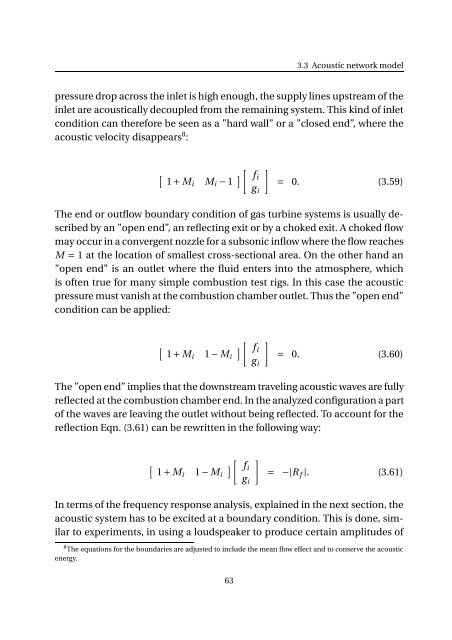Impact of fuel supply impedance and fuel staging on gas turbine ...
Impact of fuel supply impedance and fuel staging on gas turbine ...
Impact of fuel supply impedance and fuel staging on gas turbine ...
Create successful ePaper yourself
Turn your PDF publications into a flip-book with our unique Google optimized e-Paper software.
3.3 Acoustic network model<br />
pressure drop across the inlet is high enough, the <str<strong>on</strong>g>supply</str<strong>on</strong>g> lines upstream <str<strong>on</strong>g>of</str<strong>on</strong>g> the<br />
inlet are acoustically decoupled from the remaining system. This kind <str<strong>on</strong>g>of</str<strong>on</strong>g> inlet<br />
c<strong>on</strong>diti<strong>on</strong> can therefore be seen as a ”hard wall” or a ”closed end”, where the<br />
acoustic velocity disappears 8 :<br />
[<br />
1+ Mi M i − 1 ][ f i<br />
g i<br />
]<br />
= 0. (3.59)<br />
The end or outflow boundary c<strong>on</strong>diti<strong>on</strong> <str<strong>on</strong>g>of</str<strong>on</strong>g> <strong>gas</strong> <strong>turbine</strong> systems is usually described<br />
by an ”open end”, an reflecting exit or by a choked exit. A choked flow<br />
may occur in a c<strong>on</strong>vergent nozzle for a subs<strong>on</strong>ic inflow where the flow reaches<br />
M = 1 at the locati<strong>on</strong> <str<strong>on</strong>g>of</str<strong>on</strong>g> smallest cross-secti<strong>on</strong>al area. On the other h<str<strong>on</strong>g>and</str<strong>on</strong>g> an<br />
”open end” is an outlet where the fluid enters into the atmosphere, which<br />
is <str<strong>on</strong>g>of</str<strong>on</strong>g>ten true for many simple combusti<strong>on</strong> test rigs. In this case the acoustic<br />
pressure must vanish at the combusti<strong>on</strong> chamber outlet. Thus the ”open end”<br />
c<strong>on</strong>diti<strong>on</strong> can be applied:<br />
[<br />
1+ Mi 1− M i<br />
] [ f i<br />
g i<br />
]<br />
= 0. (3.60)<br />
The ”open end” implies that the downstream traveling acoustic waves are fully<br />
reflected at the combusti<strong>on</strong> chamber end. In the analyzed c<strong>on</strong>figurati<strong>on</strong> a part<br />
<str<strong>on</strong>g>of</str<strong>on</strong>g> the waves are leaving the outlet without being reflected. To account for the<br />
reflecti<strong>on</strong> Eqn. (3.61) can be rewritten in the following way:<br />
[<br />
1+ Mi 1− M i<br />
] [ f i<br />
g i<br />
]<br />
= −|R f |. (3.61)<br />
In terms <str<strong>on</strong>g>of</str<strong>on</strong>g> the frequency resp<strong>on</strong>se analysis, explained in the next secti<strong>on</strong>, the<br />
acoustic system has to be excited at a boundary c<strong>on</strong>diti<strong>on</strong>. This is d<strong>on</strong>e, similar<br />
to experiments, in using a loudspeaker to produce certain amplitudes <str<strong>on</strong>g>of</str<strong>on</strong>g><br />
8 The equati<strong>on</strong>s for the boundaries are adjusted to include the mean flow effect <str<strong>on</strong>g>and</str<strong>on</strong>g> to c<strong>on</strong>serve the acoustic<br />
energy.<br />
63
















